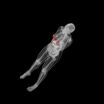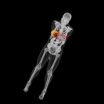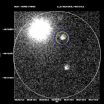(Press-News.org) DURHAM, N.C. -- Gamma and neutron imaging offer possible improvements over existing techniques such as X-ray or CT, but their safety is not yet fully understood. Using computer simulations, imaging the liver and breast with gamma or neutron radiation was found to be safe, delivering levels of radiation on par with conventional medical imaging, according to researchers at Duke Medicine.
The findings, published in the June issue of the journal Medical Physics, will help researchers to move testing of gamma and neutron imaging into animals and later humans.
Conventional medical imaging tools – including X-ray, ultrasound, CT and MRI – detect disease by finding the anatomy, or shape and size, of the abnormality. When using these tools to screen for cancer, a tumor must be large enough to be detected, and if found, a surgical biopsy is generally required to determine if it is benign or malignant.
Duke researchers are working to develop imaging technologies to detect disease in its earliest stages, much before the tumors grow large enough to be detected using conventional methods. Two imaging techniques they are researching are Neutron Stimulated Emission Computed Tomography and Gamma Stimulated Emission Computed Tomography.
Research has shown that many tumors have an out-of-balance concentration of trace-level elements naturally found in the body, such as aluminum and rubidium. These elements stray from their normal concentration levels at the earliest stages of tumor growth, potentially providing an early signal of disease.
The neutron and gamma imaging methods measure the concentrations of elements in the body, determining molecular properties without the need for a biopsy or injection of contrast media. The goal is for these tests to be able to distinguish between benign and malignant lesions, as well as healthy tissue.
"Gamma and neutron imaging may eventually be able to help us to detect cancer earlier without having to perform an invasive biopsy," said Anuj Kapadia, Ph.D., assistant professor of radiology at Duke University School of Medicine and the study's senior author.
Gamma and neutron imaging may also have applications for patients undergoing cancer treatment. Patients currently wait weeks or months to see if their cancer is responding to a particular treatment and shrinking in size, but gamma and neutron imaging may be able to tell if a treatment is working earlier by detecting molecular changes directly within the tumor.
While improved diagnostic tests would provide clinicians with useful tools, one ongoing question is the safety of gamma and particularly neutron radiation. Upon entering the body, neutrons scatter considerably, with the possibility of reaching several vital organs. Thus, researchers have been concerned about how much radiation is absorbed in the targeted organ versus surrounding tissue. For instance, in a breast scan, how much radiation is delivered unnecessarily to the heart or lungs?
Using detailed computer simulations, Kapadia and his colleagues estimated the radiation dose delivered to the liver and breast using neutron and gamma imaging. They found that the majority of radiation was delivered to organs directly within the radiation beam, and a much lower dose was absorbed by tissue outside of the radiation beam.
In simulated breast scans, the radiation was almost entirely limited to the area of the breast being scanned. The dose to the breast accounted for 96 percent of the radiation in neutron scans and 99 percent in gamma scans. The heart and lungs received less than 1 percent of the radiation dose.
When imaging the liver in simulation, the neutron scan imparted the highest radiation dose to the liver, while in the gamma scan, the stomach wall absorbed the greatest amount of radiation given its location in the direct path of the beam. Further work is needed to reduce and better target gamma radiation doses in liver scans.
"The results show that despite the use of a highly scattering particle such as a neutron, the dose from neutron imaging is on par with other clinical imaging techniques such as X-ray CT," Kapadia said. "Neutron and gamma radiation may become viable imaging alternatives if further testing proves them to be safe and effective."
The researchers will use this information to move their studies into animals, and later, humans.
INFORMATION:
In addition to Kapadia, authors include Matthew D. Belley and William Paul Segars of Duke. The study was supported by the National Institutes of Health (R01-EB001838, T32-EB007185).
New diagnostic imaging techniques deemed safe in simulations
2014-06-04
ELSE PRESS RELEASES FROM THIS DATE:
Study: When hospital workers get vaccines, community flu rates fall
2014-06-04
Anaheim, Calif., June 4, 2014 – For every 15 healthcare providers who receive the influenza vaccination, one fewer person in the community will contract an influenza-like illness, according to a study using California public health data from 2009 – 2012.
In an abstract that will be presented on June 7 at the 41st Annual Conference of the Association for Professionals in Infection Control and Epidemiology (APIC), a researcher analyzed archival data from the California Department of Public Health to determine the relationship between vaccinating healthcare personnel against ...
MU scientists successfully transplant, grow stem cells in pigs
2014-06-04
COLUMBIA, Mo. – One of the biggest challenges for medical researchers studying the effectiveness of stem cell therapies is that transplants or grafts of cells are often rejected by the hosts. This rejection can render experiments useless, making research into potentially life-saving treatments a long and difficult process. Now, researchers at the University of Missouri have shown that a new line of genetically modified pigs will host transplanted cells without the risk of rejection.
"The rejection of transplants and grafts by host bodies is a huge hurdle for medical researchers," ...
Saturated fat intake may influence a person's expression of genetic obesity risk
2014-06-04
Boston, MA (June 4, 2014) ─ Limiting saturated fat could help people whose genetic make-up increases their chance of being obese. In a new study, researchers from the Jean Mayer USDA Human Nutrition Research Center on Aging (USDA HNRCA) at Tufts University identified 63 gene variants related to obesity and used them to calculate a genetic risk score for obesity for more than 2,800 white, American men and women enrolled in two large studies on heart disease prevention. People with a higher genetic risk score, who also consumed more of their calories as saturated fat, ...
Ice cream sensations on the computer
2014-06-04
Changes in coldness, creaminess or texture that we experience in the mouth while we are eating an ice cream can be visualised on a screen using coloured curves. Graphs help manufacturers improve product quality, as proven by researchers at the Institute of Agrochemistry and Food Technology in Valencia, Spain.
In the last five years a technique known as 'Temporal Dominance of Sensations' (TDS) has become popular, used to analyse how consumer impressions evolve from the moment they taste a product.
Researchers at the Institute of Agrochemistry and Food Technology (CSIC) ...
Weight loss surgery also safeguards obese people against cancer
2014-06-04
Weight loss surgery might have more value than simply helping morbidly obese people to shed unhealthy extra pounds. It reduces their risk of cancer to rates almost similar to those of people of normal weight. This is the conclusion of the first comprehensive review article taking into account relevant studies about obesity, cancer rates and a weight loss procedure called bariatric surgery. Published in Springer's journal Obesity Surgery, the review was led by Daniela Casagrande of the Universidade Federal do Rio Grande do Sul in Brazil.
With bariatric surgery, a part ...
Observed by Texas telescope: Light from huge explosion 12 billion years ago reaches Earth
2014-06-04
Intense light from the enormous explosion of a star more than 12 billion years ago — shortly after the Big Bang — recently reached Earth and was visible in the sky.
Known as a gamma-ray burst, light from the rare, high-energy explosion traveled for 12.1 billion years before it was detected and observed by a telescope owned by Southern Methodist University, Dallas.
Gamma-ray bursts are believed to be the catastrophic collapse of a star at the end of its life. SMU physicists report that their telescope was the first on the ground to observe the burst and to capture an ...
A new approach to diversity research
2014-06-04
When people work in socially homogeneous groups, they overestimate their own contributions to the group's success, according to a new study co-authored by an MIT scholar. In fact, in some cases such "self-serving bias" occurs to a degree about five times as great in homogeneous groups as in ethnically diverse groups.
Such results raise a larger point, suggests Evan Apfelbaum, the W. Maurice Young Assistant Professor of Organization Studies at the MIT Sloan School of Management, and the lead author of the new study: Researchers have often used homogeneous social groups ...
NASA should maintain long-term focus on Mars as 'horizon goal' for human spaceflight
2014-06-04
WASHINGTON – Arguing for a continuation of the nation's human space exploration program, a new congressionally mandated report from the National Research Council concludes that the expense of human spaceflight and the dangers to the astronauts involved can be justified only by the goal of putting humans on other worlds. The report recommends that the nation pursue a disciplined "pathway" approach that encompasses executing a specific sequence of intermediate accomplishments and destinations leading to the "horizon goal" of putting humans on Mars. The success of this approach ...
Multilingual or not, infants learn words best when it sounds like home
2014-06-04
Los Angeles, London (June 04, 2014). Growing up in a multilingual home has many advantages, but many parents worry that exposure to multiple languages might delay language acquisition. New research could now lay some of these multilingual myths to rest, thanks to a revealing study that shows both monolingual and bilingual infants learn a new word best from someone with a language background that matches their own.
While 1.5 year old babies are powerful word learners, they can have difficulty learning similar-sounding words (e.g., "coat" and "goat"). A string of previous ...
Shaken, not stirred: Control over complex systems consisting of many quantum particles
2014-06-04
This news release is available in German.
Sometimes quantum particles behave like waves. This phenomenon is often used for high precision measurements, for instance in atomic clocks. Usually, only the wave properties of single particles play a role, but now researchers at the Vienna Center for Quantum Science and Technology, Vienna University of Technology have succeeded in quantum mechanically controlling hundreds of Rubidium atoms of an ultracold Bose-Einstein-condensate by shaking it in just the right way. Now, not only internal states of atoms can be used for ...





